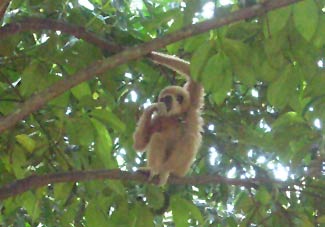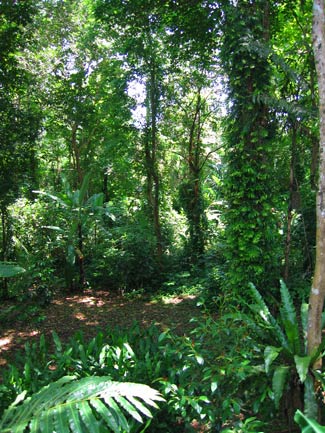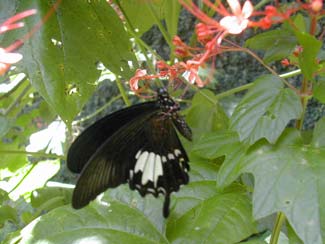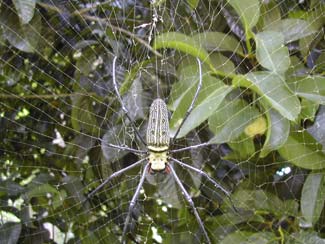Tree Tops Jungle Safaris
Khao Sok National Park

Khao Sok National Park
Wildlife
This area is one of South-east Asia’s most vital wildlife habitats. Almost 50 species of animal live here, including wild elephants, gibbons, civets, Malay sun bears and long-tail macaques. Joining them are over 300 species of bird, 38 species of bat and insects galore!
Don’t be too disappointed if you don’t see any animals - they don’t come out to give us a show! In fact they know exactly where we go and so will purposefully stay away. However, even if you can't see them, you’ll still be able to hear them all around!
The Elephant
The largest land mammal in the world can be found in Khao Sok National
Park, although there are reported to be only around 100 of them residing
here in the wild.
Elephants are very social animals and live in herds. They weigh 2,000-3,000 kg and need 250kg of food and 200 litres of water every day!
They munch away on bamboo, bananas, grass, fruit, leaves - and mud! They choose to eat mud as the rest of their diet doesn’t provide them with enough minerals.
If you are lucky to see elephants in the wild, stay well clear until they have passed. They are very protective of their young and will have no hesitation in charging at you if they feel threatened in any way. Admire these beasts from afar and you will be rewarded with a fantastic sight!
Gibbon
The lar gibbon or white-handed gibbon can be found in Khao Sok. They
are either chocolate brown or creamy blond in colour and can normally
be distinguished by a white ring around their face and, of course, white
hands and feet!
They move around using their long arms to swing from branch to branch (rather than jumping like monkeys do). These strong arms take them far across the canopy (several km per day) in search of fruit, their staple diet.
A visit to Khao Sok wouldn’t be the same without hearing this
gibbon’s call or song, normally heard early in the morning. A female’s
song is different to that of a male, but you’ll often hear a couple
singing a duet, letting the world know that they are together and that
this is their territory.
Hornbill
The hornbill is one of the oldest birds on earth – dating back
15 million years it’s prehistoric. Listen to the sound of its wings
in flight (whoosh, whoosh, whoosh) and you might be mistaken for thinking
you’re on the set of Jurassic Park!
There are 54 species of hornbill with the helmeted hornbill and black
hornbill being the most common in Khao Sok. Their most prominent feature
is a horn on the top of their bill, although no-one knows its purpose
When it comes to nesting, hornbills are very choosy, spending several
days trying to find just the right tree. Once they’ve found the
right one, they’ll return there year after year.
The nest is made in the hollow of a tree and, when the chicks are born,
sealed with regurgitated food, droppings and mud brought by the male
to ensure a predator-proof nest! A model stay-at-home mum, the female
will mother her chicks for four months until they’re ready to fly
from the nest.
Malaysian sun bear
Malaysian sun bears are the smallest bears in the world. Black in colour
with a distinctive white crescent displayed across their chest, they
roam the forest year round.
In the case of the sun bear size doesn’t matter! These bears might
be small but they have sharp claws and teeth and are very aggressive!
If you see one, back off!
They are the best climbers of all the bear species and spend a lot of
time sprawled out on a branch lying on their stomach with all four legs
hanging down! Cute…, but extremely dangerous.
Cicada
The cicada is a small insect which makes a high-pitched shrill sound
– you can’t fail to hear it! This distinctive shrill is actually
a male cicada singing a love song to attract a mate. They make this
noise by contracting their thorax up to 1,000 times per second!
Each species of cicada has a different song and so as not to confuse
the females, each has its own time slot during the day to sing. Spend
a bit of time in Khao Sok and you may start to become familiar with
the different songs.
Cicada nymphs start off wingless and may spend up to 15 years below
the forest floor, slowly developing and working their way up to the
surface. Once they emerge, they then work their way up the trunk of
a tree and transform into an adult with wings. Having spent so long
below the surface, no wonder they want to sing their hearts out!
Of course there’s many other animals that you might see: civets,
squirrels, rats, geckos, lizards, snakes, spiders - the list goes on…Keep
your eyes and ears open – you never know!




